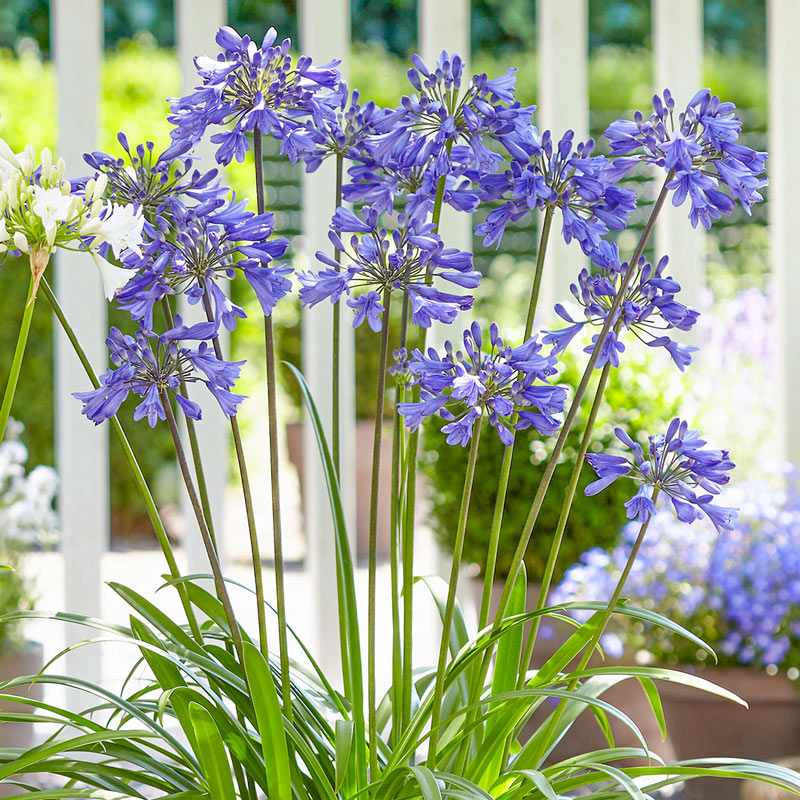Growing Agapanthus: A Total Overview to Beautiful Blooms
Growing Agapanthus: A Total Overview to Beautiful Blooms
Blog Article
Grasping the Art of Agapanthus Treatment: Necessary Actions for Healthy Development and Lively Blooms
In the realm of cultivation, the cultivation of agapanthus stands as a gratifying undertaking for those that seek to nurture these stylish flowering plants. From choosing the ideal selection to understanding pruning strategies, the journey towards cultivating prospering agapanthus plants is diverse and holds the key to unlocking the full possibility of these herb treasures.

Selecting the Right Agapanthus Selection

When picking the appropriate Agapanthus range for your yard, think about factors such as environment viability, flower color, and growth habit. Furthermore, think about the environment in your area to guarantee the Agapanthus selection you select can grow in your specific conditions. Understanding the growth habit of various Agapanthus ranges is vital for proper positioning within your garden.
Perfect Growing Conditions
Considering the optimal ecological needs is important for effective Agapanthus cultivation. Agapanthus prospers in well-draining dirt with a somewhat acidic to neutral pH degree. When growing, pick an area that receives full sunlight to partial color. In hotter climates, offering some afternoon shade can prevent scorching of the leaves. Agapanthus plants are sensitive to cool temperatures and must be secured from frost during cold weather.
To guarantee healthy and balanced development and lively blooms, plant Agapanthus light bulbs at a depth of regarding 2-4 inches and area them 8-12 inches apart. Mulching around the base of the plants aids maintain dampness and suppresses weed development.
Watering and Feeding Tips
Keeping correct wetness levels and supplying necessary nutrients are crucial elements in the treatment regimen for Agapanthus plants. It is critical to strike an equilibrium when it comes to watering Agapanthus. These plants prefer consistently damp dirt yet are prone to root rot if overwatered. During the growing period, water deeply once a week, making certain the dirt is well-draining to avoid waterlogging. In hotter environments or throughout durations of dry spell, more constant watering may be essential to keep the dirt evenly damp. However, lower watering in the winter to prevent water logged problems.
Feeding Agapanthus is crucial for promoting healthy and balanced growth and prolific blossoms. Apply a balanced fertilizer, such as a 10-10-10 formula, in the very early springtime as new development emerges. Repeat this application every 6-8 weeks throughout the growing period. Prevent extreme fertilization, as it can result in lavish foliage at the expense of blossoms. Constantly comply with the producer's directions for proper dilution and application methods. By complying with these watering and fertilizing pointers, you can ensure your Agapanthus plants prosper and produce vivid, long-lasting blossoms.
Pruning Methods for Agapanthus
Trimming Agapanthus plants at the appropriate times and with correct techniques is essential for keeping their health and wellness and promoting optimum growth and flowering. The perfect time to trim Agapanthus is in late winter months or early springtime prior to new growth emerges.
For flowered stems, wait till the blossoms have actually perished and after that cut them back to the base. This not only cleans the plant's look yet likewise encourages the development of new flower buds. Deadheading invested flowers can likewise redirect the plant's power into creating even more blossoms rather than establishing seeds. Nevertheless, if you wish to collect seeds for breeding, leave some blossoms to dry and fully grown on the plant.
Bear in mind to use clean, sharp devices to make exact cuts and reduce the danger of introducing diseases. Agapanthus. Normal trimming will certainly assist maintain your Agapanthus looking healthy and balanced and cool while guaranteeing an abundant display of beautiful blossoms
Taking Care Of Typical Pests and Conditions
After ensuring proper trimming strategies Clicking Here for Agapanthus, it is crucial to attend to typical bugs and illness that can affect the wellness and vigor of these plants. One typical parasite that affects Agapanthus is the Agapanthus gall midge.
Furthermore, Agapanthus plants can experience from origin rot if they are planted in improperly draining pipes soil. By being vigilant and taking timely activity against conditions and pests, you can help your Agapanthus plants flourish and generate dynamic blossoms. Agapanthus.

Final Thought
To conclude, understanding great post to read the art of agapanthus care involves selecting the best range, providing suitable planting problems, appropriate watering and feeding, ideal pruning techniques, and addressing usual parasites and illness. By following these necessary steps, you can guarantee healthy development and lively blooms for your agapanthus plants. Remember to regularly check and keep your plants to promote their total health and long life.
To make sure healthy development and vibrant flowers, plant Agapanthus bulbs at a depth of regarding 2-4 inches and room them 8-12 inches apart. By complying with these watering and feeding pointers, you can ensure your Agapanthus plants flourish and create vivid, lasting blossoms.
One typical pest that affects Agapanthus is the Agapanthus gall midget. Furthermore, Agapanthus plants can endure from root rot if they are grown in inadequately draining pipes dirt. By next page complying with these necessary actions, you can ensure healthy and balanced development and vibrant flowers for your agapanthus plants.
Report this page